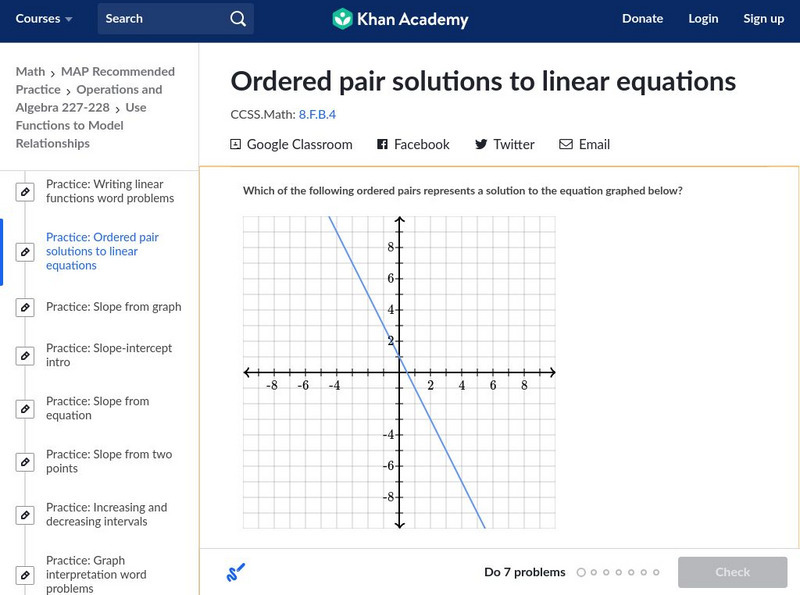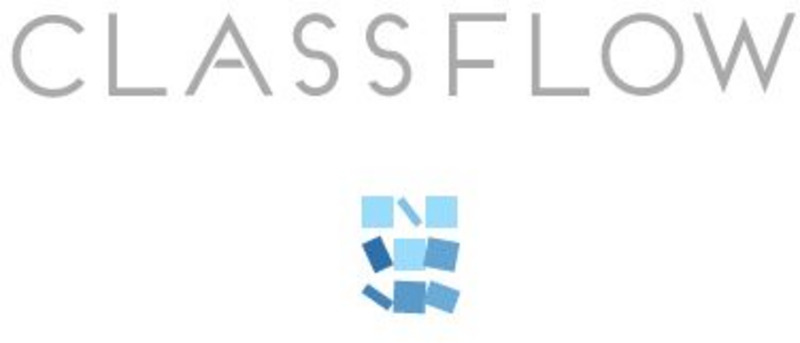ClassFlow
Class Flow: Graphing Inequalities
[Free Registration/Login Required] Students represent functional relationships using tables, equations, and graphs, and describe the connection among these representations.
Khan Academy
Khan Academy: Linear Equations Word Problems: Tables
Solve word problems about real world relationships that are given in tables. Students receive immediate feedback and have the opportunity to try questions repeatedly, watch a video or receive hints.
Other
Nearpod: Two Variable Inequalities
In this lesson, students will graph linear inequalities and determine the solution set.
Varsity Tutors
Varsity Tutors: Hotmath: Graphing Calculator Practice Problems: Point, Line, Planes, Angles
Practice using your graphing calculator for drawing and labeling points, lines, planes, and angles. If you get stumped or if you would like to check your work, then select the View Solution button, which is located directly under each...
Texas Education Agency
Texas Gateway: Writing Verbal Descriptions of Functional Relationships
Given a problem situation containing a functional relationship, the student will verbally describe the functional relationship that exists.
Khan Academy
Khan: Lesson 5: Relationships Among Linear Equations, Lines in Coordinate Plane
This lesson focuses on the relationship between algebraic, graphical, and contextual expressions of linear equations.
Khan Academy
Khan Academy: Algebra I: Exponential vs. Linear Growth Over Time
Practice analyzing the end behavior of two functions that model similar real-world relationships, where one function is exponential and the other is polynomial. Students receive immediate feedback and have the opportunity to try...
Khan Academy
Khan Academy: Ordered Pair Solutions to Linear Equations
Determine which ordered pair represents a solution to a graph or equation. Students receive immediate feedback and have the opportunity to try questions repeatedly, watch a video or receive hints.
Texas Instruments
Texas Instruments: Inequalities, They Are Not Just Linear Anymore!
Students study quadratic relationships and explore the process of graphing quadratic inequalities and systems of quadratic inequalities. They will solve these inequalities algebraically and graph them on a coordinate plane.
ClassFlow
Class Flow: Patterns Graphs
[Free Registration/Login Required] In this lesson students will understand linear relations and functions. They will create graphs and analyze graphs of linear equations.
Khan Academy
Khan Academy: Equations & Inequalities Word Problems
HSA-CED.A.1: Interactive resource which create equations and inequalities in one variable and use them to solve problems. Include equations arising from linear and quadratic functions, and simple rational and exponential functions....
TeachEngineering
Teach Engineering: Forces and Graphing
This activity can be used to explore forces acting on an object, to practice graphing experimental data, and/or to introduce the algebra concepts of slope and intercept of a line. A wooden 2x4 beam is set on top of two scales. Students...
Rice University
Rice University: The Hand Squeeze
Students will enjoy this data collection and class analysis experiment involving the time it takes for a hand squeeze to travel around a circle of people. From organizing the activity to collecting the data to making a table and graphing...
Shodor Education Foundation
Shodor Interactivate: Lesson: Lines, Rays, Line Segments, & Planes
This robust lesson plan for upper elementary and middle school grades introduces the concepts for lines, rays, line segments, and planes. Resources are linked to it and ready for your use.
Texas Instruments
Texas Instruments: Getting Started With the Ti Navigator: What's My Line
This lesson introduces students to Activity Center and is intended to help students understand the meaning of slope and y-intercept. They will explore the relationships between symbolic expressions and graphs of lines by using Activity...
Illustrative Mathematics
Illustrative Mathematics: F if a Sse Modeling London's Population
In this task, students are shown a table of population data for the city of London and are asked to explore whether a linear, quadratic, or exponential function would be appropriate to model relationships within the data. They are next...















